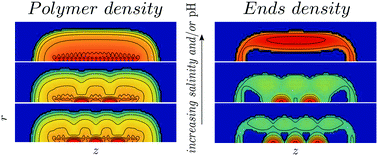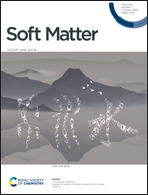Intramolecular micellization and nanopatterning in pH- and thermo-responsive molecular brushes†
Abstract
Conformational transitions and nanoscale self-organization triggered in double pH- and thermo-responsive molecular brushes by varying environmental conditions are studied by means of analytical mean-field theory and numerical Scheutjens–Fleer self-consistent field modelling. Such molecular brushes are composed of multiple thermo-responsive side chains end-grafted onto the main chain (backbone) and are capable of acquiring ionic charges via reversible (de)protonation of the monomer units. Competition of long-range Coulomb repulsion with short-range solvophobic interactions leads to complex patterns in the intramolecular self-organization of molecular brushes. In particular, we observed formation of pearl necklace-like structures with multiple dense nanodomains formed by weakly ionized collapsed side chains and stabilized by a fraction protruding into the solution and strongly ionized ones. Such structures are thermodynamically stable in a certain parameter range and can be termed as intramolecular micelles. The stimuli-induced intramolecular nanopatterning occurs via a sequence of quasi-first order phase transitions corresponding to splitting/fusion of collapsed domains accompanied by jumps in the average degree of ionization and macromolecular dimensions. A re-entrant sequence of transitions is observed when the salt concentration is used as a control parameter. These theoretical predictions provide guidelines for design of smart unimolecular devices, for example multicompartment nanocarriers of active substances or nanosensors.



 Please wait while we load your content...
Please wait while we load your content...